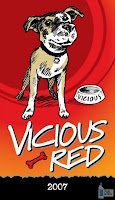
Those of you who frequently read my reviews know I have a few avoidance wines, one of them being FishEye. Back in October I reviewed Fish Eye’s Cabernet Sauvignon and was quite pleased but for whatever reason have not tried any other varietals. I just tend to shy away from some wines. But in the name of providing good wine information I must face my fears, again. I decided it was time to pick up a bottle of FishEye Shiraz 2008.
The glass is filled with smoky oak and black berry aromas. Flavors are a little sweet but the oak and berry flavors carry over as well as cassis and spice with a nice soft, balanced finish.
From the website you get the feeling FishEye isn’t about wine snobs but more about having fun with wine. The wines also seem geared towards the 22-27 year old age bracket. In my book, that that qualifies this line of wines as starter wines. In 2007 FishEye was named Hot BRAND by Market Watch. They even boast you can write about their wines in value wine columns. Hey, I’m all for fun, and inexpensive wine and at $5.99, you can’t get much more inexpensive and still be drinkable.
So what’s my take on FishEye Shiraz, I wouldn’t serve it at a dinner party nor would I give it as a gift but if you’re looking for something to sip outside in the upcoming summer months, this wine may be a good one to try.
2010© Kellie Stargaard. All Rights Reserved.
http://winechicksguidetoeverydaywines.blogspot.com/
Follow me on:
Facebook:http://www.facebook.com/home.php#/group.php?gid=114185461044&ref=ts
Twitter:http://twitter.com/WineChicksGuide
The glass is filled with smoky oak and black berry aromas. Flavors are a little sweet but the oak and berry flavors carry over as well as cassis and spice with a nice soft, balanced finish.
From the website you get the feeling FishEye isn’t about wine snobs but more about having fun with wine. The wines also seem geared towards the 22-27 year old age bracket. In my book, that that qualifies this line of wines as starter wines. In 2007 FishEye was named Hot BRAND by Market Watch. They even boast you can write about their wines in value wine columns. Hey, I’m all for fun, and inexpensive wine and at $5.99, you can’t get much more inexpensive and still be drinkable.
So what’s my take on FishEye Shiraz, I wouldn’t serve it at a dinner party nor would I give it as a gift but if you’re looking for something to sip outside in the upcoming summer months, this wine may be a good one to try.
2010© Kellie Stargaard. All Rights Reserved.
http://winechicksguidetoeverydaywines.blogspot.com/
Follow me on:
Facebook:http://www.facebook.com/home.php#/group.php?gid=114185461044&ref=ts
Twitter:http://twitter.com/WineChicksGuide







